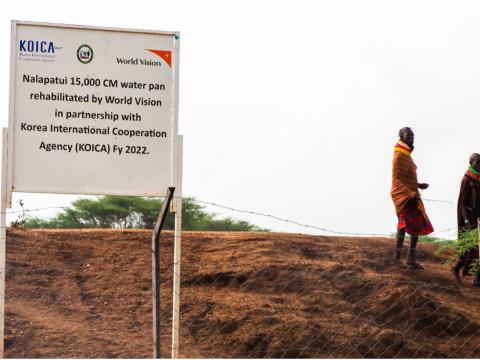How Nalapatui Water Pan is Uniting Communities and Keeping Drought at Bay

On a mid-morning Friday in Nalapatui village, Turkana West, thick dark clouds gather, signaling the arrival of heavy rains—an unusual yet welcome sight in an area plagued by notoriously unreliable rainy seasons. These rains are nothing short of a double blessing for this community, which has weathered prolonged droughts.
Recurrent droughts and an unstable water supply have been the greatest challenges for the communities in this region. Logialan Alibango, Chairman of the Nalapatui Water Users Committee, explains that the drought had dried up all nearby water sources, forcing community members to trek over 30 kilometers in search of water for both domestic use and livestock.
Pastoralists from the Turkana community have long been compelled to move with their livestock to neighboring Uganda and Sudan during drought seasons, searching for water and pasture. “We had to take our animals all the way to Uganda for water, which often led to conflicts with other communities who also depend on the same water points. Sometimes, we even had to offer a goat or cow as payment,” Alibango recalls.

Livestock is the economic backbone for many residents in this area. Providing water for cattle is crucial, as it sustains many livelihoods in the hope that the rains will return. However, the rains have failed for five consecutive seasons, leading to untold human suffering and massive livestock losses. © World Vision Photo/Felix Pilipili
For years, the region has faced shifting precipitation patterns and increasingly extreme weather, which has impacted human health, food security, safety, and socio-economic development. "The drought has been devastating, and the situation worsens day by day. We depend on our animals for our livelihoods, but drought and cattle rustlers are taking them away, leaving the families poorer," says Alibango.
With the growing population further straining already scarce natural resources, World Vision partnered with the Korea International Cooperation Agency (KOICA) through the Kalobeyei Integrated Drought Response and Management (KDREAM) Project to initiate a transformative water project in the region, offering hope for a sustainable future.
The renovated water pan has saved this community the agony of traveling for days in search of water during dry seasons. It has also helped the community avert existing armed conflicts, which have led to simmering tensions between the Kenyan government and its neighboring countries.
Turkana West Sub-County Water Inspector, Mr. David Nalokio Lobuin, emphasizes, “A lack of water has caused untold suffering in this community, contributing to food insecurity, endemic malnutrition, border security issues, and various forms of violence against children and women.”
Since 2022, the KDREAM project, in collaboration with the Turkana County government, has worked closely with communities to establish reliable water points to mitigate the devastating impacts of climate change and inter-communal conflict.
As part of this effort, the project rehabilitated a 15,000m³ water pan at Nalapatui in Turkana West to address the tensions and conflicts arising from limited access to water and pasture. The water catchment system was fenced off to ensure the water quality for livestock.

Previously, the water pan was clogged with accumulated silt, preventing rainwater from being effectively collected. Dwindling water supplies and limited pasture heightened the risk of inter-community conflicts.
Anthony Oyugi, the KDREAM Programme Manager, explains, “The root cause of conflicts in this pastoral community is competition over natural resources such as pasture and water. These conflicts have led to the loss of lives and property and disrupted children’s access to education.”
Mr. Oyugi adds, “By providing water, empowering the community to plant grass, and encouraging them to diversify their livelihoods through climate-smart agriculture technologies, we believe these interventions will build community resilience to climate change-related shocks.”

World Vision has also supported the repair of four boreholes and reactivated, registered, and built the capacity of existing Water User Committees to manage and maintain these critical natural resources sustainably.
Nalapatui Village is roaring back to life, as communities living near the water pan have started practicing crop farming to feed their families. Thanks to World Vision's interventions, peace is returning to the area, and life is steadily improving.
Residents now enjoy a sense of calm, with enough water available for their livestock. “With water readily accessible, community movements have decreased, allowing families to settle in their homes and enabling children to attend school,” says Alibango.
By Felix Pilipili, Communications Specialist, World Vision Kenya